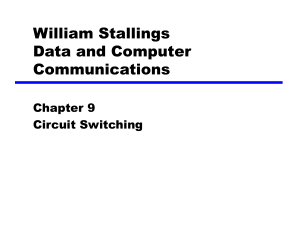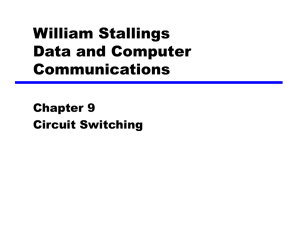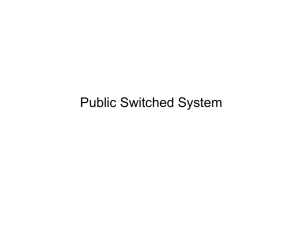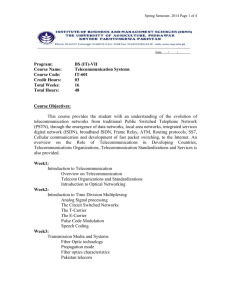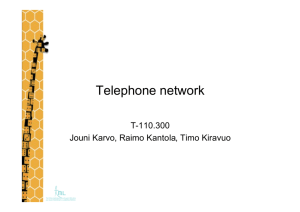(PSTN)-2
advertisement
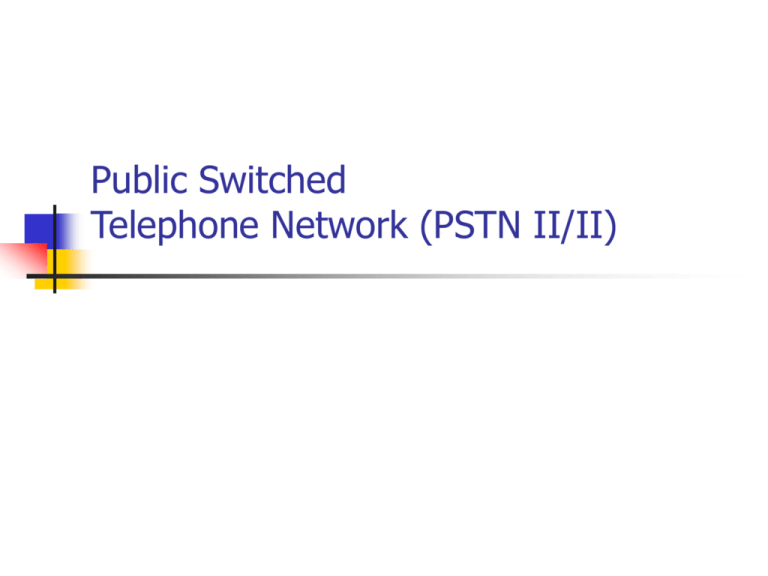
Public Switched Telephone Network (PSTN II/II) Topics today in PSTN Trunk Network Node 1 Node 2 Access Access Node 3 Terminals A: Switching types Terminals Connectionless/ connection oriented Packet/circuit B: PSNT exchanges and interfaces interface Q.512 using access and trunk networks signaling network management internetworking (telecommunications between networks) 2 Switching in public networks Cell switching - resembles packet switching - difference: cells (packets) have a fixed size : offers bounded delay guarantees (QoS compatible, long packets won’t stuck cells) (fixed length) CSPDN: Circuit switched public data net* PSPDN: Packet switched public data net** DQDB: Distributed queue dual bus * Used by European Telecom’s that use X.21 in circuit switched nets 3 **Used by British Telecom’s Packet-switched Service (PSS), Data Pac (Canada) ... Circuit switching Circuit switching - dedicated path - constant delay/bandwidth - voice/data - paid by time - examples: PSTN, VPN Time switch - Makes switching between time slots - In the figure incoming slot 3 is moved to outgoing slot 3 for one voice direction - Each coming timeslot stored in Speech Store (SS) - Control store (CS) determines the order the slot are read from SS - The info in CS is determined during setup phase of the call Space switch - makes switching between PCM lines - works with electronic gates controlled by CS Cross-point controlled by CS TDMA 4 Packet switching Packet structure Seq: sequence number Op code: message/control identifier CRC: Cyclic Redundancy Code Note: - source address required for retransmission in ARQ - byte count could be also an end flag Node structure 5 Connection-oriented and connectionless switching Connection oriented - Applies same route - QoS well defined - Phases - Connection setup - Data transmission - Release - Packets received in same order - Example: ATM, frame relay, PCM Connectionless - Use of different routes for each packet possible - Each packet have address fields - QoS not guaranteed - Packets may come in different order - Example: IP (Internet Protocol), TCP takes care of cleaning the mess 6 Transfer modes & connections summarized Transfer modes PSTN Circuit switching for voice ISDN -- developed nowadays also for data PCM - well-specified delays - echo problems Connection types ATM Connection oriented Frame-relay - hand-shaking - strict error requirements - for fast data transfer X.25 Packet switching - developed for data - nowadays also for voice - Statistical multiplexing - variable delays IP, Frame-relay ATM Connectionless - broadcasting - modest error rates often accepted - fast data in good channels IP, UDP* 7 *User Datagram Protocol Example of cell switching: Distributed queue dual buss (DQDB) LAN Function - transport units constant length - access units access info in the ring: access unit - know subscribers in access unit’s subnets and route packets for them - access protocol applies token ring Properties - distributed switching (Compare to FDDI*) - ATM compatible - rates: 64 kb/s ... 45 Mb/s - geographical limit up to 200 km access unit access unit LAN access unit *FDDI: Fiber Distributed Data Interface see: http://www.iol.unh.edu/training/fddi/htmls/ Transport Unit (same as in ATM) 8 Connecting into PSTN exchange: Equipment in the access network Distribution point On-line subscriber with several telephones Cross connection point Twisted pair - connection ISDN 2B+D 144 kb/s Q.512 specifies exchange interfaces Wireless access (or radio access point) ISDN connection example: 30B+D (2.048 Mb/s) Business subscriber Multiplexer Private Branch Exchange 9 Local exchange Signaling (SS7) with users and other exchanges to other exchanges PBX ETC Subscriber stage Group switch Announcement equipment Test/measurement equipment Switch - Operation & maintenance support (Q.513) - Charging Control system - Supplementary (IN) services - Subscriber data, switch control Control Signaling equipment Third-party equipment Traffic concentration conference calls, call waiting, broadcasting ... ETC: Exchange terminal circuit IN: Intelligent network 10 Subscriber stage Connects to: digit receivers, info tones, test equipment internet access (DSLAM) centrex service To ETC MUX Concentrator Control System: subscriber authentication, routing, billing, O & M, ... ETC: Exchange terminal circuit Speech store: shift registers storing bits for time switching 11 Control store: gates guiding speech store switches Exchange control functions Maintenance functions supervision of subscriber lines and trunk circuits Operational functions administrative data as subscriber database routing database statistical data as from where and whom subscribers call holding times for different equipment types utilization of IN services User services Sample of IN services 12 Exchange user services (examples) Absent-subscriber services as the answering machine Call booking: connection at the desired time Person-to-person call: ensures that call goes to a right person Serial call: setting up several calls Telephone conferencing: several persons participate to call in real-time (compare: teleconferencing) Directory inquiries: also speech recognition, recorded messages (many of these nowadays available in terminals) 13 The space-switch (used as a cross-switch and concentrator) Number of cross-connections reduced compared if a simple space division matrix of NxM (input x output) would be used Usually performs concentration: Blocking possible Same signal can be routed via different paths: increased reliability 14 The time-switch One of the time slots of any full-duplex lines is connected to some other line (at a time) Thus two switches / time slot connect a line For 100 full-duplex lines at 19.6 kbps a 1.92 Mbps bus is thus required for no blocking If no fixed assignment of input lines to time slot but on demand allocation -> blocking switch that reduces number of switches and switch clock frequency. For instance 200 lines of 19.6 kbps with bus of 1.92 Mbps -> about half of the devices can connect at any time, eg concentration is 2:1 15 The time-space-time (TST) switch Works in local exchange and subscriber stage Performs PCM concentration, usually 10:1 … 3:1 Connects subscribers also to information tones and test equipment Time switch contains one bus for incoming and outgoing calls (full-duplex) Space switch Time switch Subscriber stage Question: Why time or space switch is not always enough? Time switch 16 PSTN ISDN exchange interfaces (Q.512) NT CN V1 LT ET LT V2 ET ET ET X ISDN PABX AN LT LT Peek to Q-recommendations V3 V5 ET ET A V4 ET LT LT B LT CN:Concentrator ET:Exchange T. LT:Line T. AN:Access Net. NT:Network T. (in ISDN) T:Terminal 17 Exchange interfaces and tasks, V1 Purpose of exchange is to organizes connection between exchange terminators! V1: Access to basic ISDN (This is user’s ISDN-u interface that can be used to connect small PBX also) Basic ISDN V1-functions: 2 B + D (2x64 kbps + 16 kbps) channeling structure timing and frame synchronization activate and deactivate terminator operation and maintenance feeding power supply ISDN basic access parameters defined in G.961 18 Exchange interfaces and tasks, V2-V4 V2: Interface serves typically concentrators 2048 kbit/s eg 30 B + D Electrical standard G.704 V3: Resembles V2 but intended for interface other exchanges (PABX) Electrical standard G.703 30 B + D at 2048 kb/s also 23 B +D at 1544 kb/s (I.431) V4:Interface to private networks (not ITU-T specified), for instance DSLAM (ADSL-interface) 19 Exchange interfaces and tasks, V5 Between access network and exchange 2048 kbit/s Specifies basic interfaces for Analog access ISDN-access Electrical interface G.703 Channel control and signaling V5 supports interface rates 2048 kbit/s … 8448 kbit/s 20 Connecting the local loop: Line interface circuit (LIC) Used for signaling in certain coin-operated pay-phones and PBX 21 Line interface circuit components Over-voltage protection Test equipment to connect to monitor the line condition faults Voltage feed ringing telephone current supply Detection of hook stage, pulse generated, or dual-tone receiver The hybrid junction (2 wire - 4 wire interface) An A/D converter (uses PCM techniques at 64 kbps) 22 The hybrid circuit 4-wire connection is used between exchanges and 2-wire connections from exchange to subscribers Exchange A Amplifier Exhange B Two-wire Two-wire Amplifier Bridge Bridge 23 The hybrid-circuit If the impedance Zb equals the line impedance no incoming voice (down right) leaks to outgoing voice (up right) but the signal goes via the two wire connection on the left To exchange Local loop From exchange 24 The hybrid circuit summarized The hybrid circuit transforms two-wire connection into 4wire connection. If the hybrid is unbalanced echo will result Hybrid is balanced when no own voice is leaked into own loudspeaker Hybrid unbalance can result from line impedance changes due to weather conditions Unbalance results echo Echo cancellation circuits are harmful in data connections Nowadays realized by operational amplifier based circuitry that automatically monitors line impedance changes 25 Network echo suppressor (NES) R: transmission gate, A: attenuator, L: logic circuit When the signal is present on the receiving line the transmitting line is cut-off A kind of semi-duplex approach to solve the echo problem 26 Network echo canceller (NEC) Signal echo is extracted and subtracted from the received signal More effective than echo suppressor. Often NEC and NES are however both used 27 PSTN operation and maintenance (Q.513) Different alarm classes Vital functions and circuits (as SS7 and group switch) use secured paths and backups Procedures provided for: troubleshooting fault diagnostics hardware faults can be isolated Supervision is realized also by connecting maintenance units to the network Important switches have extensive backup equipment A supervision plan by network levels: 28 Modern PSTN hierarchy to international level Transit exchange Regional transport level Local transport level Local exchange Access transport level 29 PSTN Hierarchy cont. Local (example, within a city) Subscriber connections Switching within the local exchange Switching to other exchanges Transit (county level, say between Tampere and Helsinki) Switching traffic between different geographical areas within one country International Gateway-type traffic between different countries DWDM (Dense Wavelength Division Multiplexing) routes Rates can follow SONET or SDH standard SDH - transport of 1.5/2/6/34/45/140 Mbps within a transmission rate of 155.52 Mbps - carries for instance ATM and IP within rates that are integer multiples of 155.52 Mbps 30 Subscriber signaling for local calls 31 Inter-exchange signaling Channel associated signaling (CAS) as No.5, R1, R2 analog and digital connections Modern ISDN exchanges apply SS7(digital), that is a common channel signaling method (CSS) that is discussed later in its own lecture CAS is divided into line and register signaling: Line signaling: line state between the trunk-links as answer, clear-forward*, clear-back Register signaling: routing information as B-number, A-category, B-status *A-subscriber on-hook message transmitted to B exchange 32 Inter exchange signaling (cont.) Three categories of information is transmitted: setup, supervision clearing service related information as forwarding, callback, charging status change information transmission network congestion neighborhood exchange congestion 33 Example of inter-exchange signaling 34 Inter-exchange signaling (cont.) 35 A case study: DX 200 Exchange Various control units apply common busses to control the exchange SSU PAU CCSU LSU CCMU CM CHU STU M MFSU DCU OMU 36 A case study: DX 200 Exchange SSU: Subscriber Signaling Unit: controls access network CCSU:Common Channel Signaling Unit (SS7). CCMU: Common Channel Signaling Management Unit: (as MTP, SCCP) PAU: Primary Rate Access Unit: controls basic (64 kbit/s) system interfaces LSU: Line Signaling Unit: takes care of signaling between transit exchanges and access networks MFSU: MULti-frequency Service Unit: Takes care of signaling when multiple frequency signals are used MTP: Message transfer part of SS7 SCCP: Signaling connection control part =SS7 bearer part: network service part (NSP) 37 A case study: DX 200 Exchange (cont.) BCDU:Basic Data Communication Unit: Serves various data services to OMU as access to X.25 and LANs M: Marker Unit: Controls concentrators / space switches CM: Central Memory: Contains user database, charging, signalling, routing and exchange ensemble. STU: Statistical Unit: Collects statistical information on traffic and charging. CHU:Charging Unit: Maintains charging database obtained from signalling units. OMU:Operation and Maintenance Unit: Allows personnel access to exchange memory, perform tests an traffic measurements. 38 39

